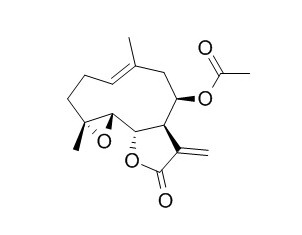Lipiferolide
Lipiferolide is an inhibitor of farnesyl protein transferase(FPTase), it inhibits the FPTase activity in a dose-dependent manner, and shows cell growth inhibitory activity against several tumor cells, it possesses cytotoxic activity against KB cells. Liriodenine also has antiplasmodial activity.
Inquire / Order:
manager@chemfaces.com
Technical Inquiries:
service@chemfaces.com
Tel:
+86-27-84237783
Fax:
+86-27-84254680
Address:
1 Building, No. 83, CheCheng Rd., Wuhan Economic and Technological Development Zone, Wuhan, Hubei 430056, PRC
Providing storage is as stated on the product vial and the vial is kept tightly sealed, the product can be stored for up to
24 months(2-8C).
Wherever possible, you should prepare and use solutions on the same day. However, if you need to make up stock solutions in advance, we recommend that you store the solution as aliquots in tightly sealed vials at -20C. Generally, these will be useable for up to two weeks. Before use, and prior to opening the vial we recommend that you allow your product to equilibrate to room temperature for at least 1 hour.
Need more advice on solubility, usage and handling? Please email to: service@chemfaces.com
The packaging of the product may have turned upside down during transportation, resulting in the natural compounds adhering to the neck or cap of the vial. take the vial out of its packaging and gently shake to let the compounds fall to the bottom of the vial. for liquid products, centrifuge at 200-500 RPM to gather the liquid at the bottom of the vial. try to avoid loss or contamination during handling.
J Korean Soc Food Sci Nutr2023, 52(11):1101-1110
Separations2021, 8(1), 1.
Oncol Lett.2020, 20(4):122.
Pharmacol Res.2020, 161:105205.
Cells. 2023, 12(15):1934.
Processes2021, 9(1), 153;
Molecules.2021, 26(12):3652.
Antiviral Res.2021, 193:105142.
Journal of Ginseng Research2023, 12.004.
Universiti Tunku Aboul Rahman2023, 6263.
Related and Featured Products
Arch Pharm Res. 2007 Mar;30(3):299-302.
Farnesyl protein transferase and tumor cell growth inhibitory activities of lipiferolide isolated from Liriodendron tulipifera.[Pubmed:
17424934]
METHODS AND RESULTS:
The methanolic extract of the leaves of Liriodendron tulipifera was found to show inhibitory activity towards farnesyl protein transferase (FPTase). Bioassay-guided fractionation of the methanolic extract resulted in the isolation of Lipiferolide, an inhibitor of FPTase.
CONCLUSIONS:
This compound inhibited the FPTase activity in a dose-dependent manner, and showed cell growth inhibitory activity against several tumor cells.
Journal of Ethnopharmacology, 2011,133(1):26-30
Antiplasmodial Activity of Aporphine Alkaloids and Sesquiterpene Lactones from Liriodendron tulipifera L[Pubmed:
20826204 ]
METHODS AND RESULTS:
Six known aporphine alkaloids, asimilobine (1), norushinsunine (2), norglaucine (3), liriodenine (4), anonaine (5) and oxoglaucine (6) were found to be responsible for the antiplasmodial activity of the bark.
CONCLUSIONS:
Leaves yielded two known sesquiterpene lactones, peroxyferolide (7) and Lipiferolide (8) with antiplasmodial activity.
The antiplasmodial activity of (2) (IC50 = 29.6 μg/ml), (3) (IC50 = 22.0 μg/ml), (6) (IC50= 9.1 μg/mL), (7) (IC50 = 6.2 μg/ml) and (8) (IC50 = 1.8 μg/ml) are reported for the first time.
Phytochemistry,1975,14(3):769-73.
New sesquiterpene lactones from Liriodendron tulipifera.[Reference:
WebLink]
METHODS AND RESULTS:
Four new sesquiterpene lactones were obtained from L. tulipifera; two germacranolides, Lipiferolide (4) and Epitulipinolide diepoxide (5) from the leaves, an elemanolide, epitulipdienolide (7), and an eudesmanolide, γ-liriodenolide (6) from the root bark. Structural determination was by physical and chemical methods and by direct correlation to the known epitulipinolide (3).
CONCLUSIONS:
Lipiferolide and Epitulipinolide diepoxide possess cytotoxic activity against KB cells.



